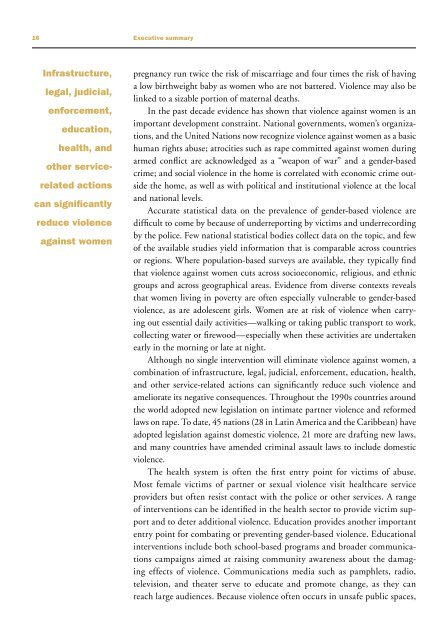Taking action: achieving gender equality and empowering women
Taking action: achieving gender equality and empowering women
Taking action: achieving gender equality and empowering women
Create successful ePaper yourself
Turn your PDF publications into a flip-book with our unique Google optimized e-Paper software.
16 Executive summary<br />
Infrastructure,<br />
legal, judicial,<br />
enforcement,<br />
education,<br />
health, <strong>and</strong><br />
other servicerelated<br />
<strong>action</strong>s<br />
can significantly<br />
reduce violence<br />
against <strong>women</strong><br />
pregnancy run twice the risk of miscarriage <strong>and</strong> four times the risk of having<br />
a low birthweight baby as <strong>women</strong> who are not battered. Violence may also be<br />
linked to a sizable portion of maternal deaths.<br />
In the past decade evidence has shown that violence against <strong>women</strong> is an<br />
important development constraint. National governments, <strong>women</strong>’s organizations,<br />
<strong>and</strong> the United Nations now recognize violence against <strong>women</strong> as a basic<br />
human rights abuse; atrocities such as rape committed against <strong>women</strong> during<br />
armed conflict are acknowledged as a “weapon of war” <strong>and</strong> a <strong>gender</strong>-based<br />
crime; <strong>and</strong> social violence in the home is correlated with economic crime outside<br />
the home, as well as with political <strong>and</strong> institutional violence at the local<br />
<strong>and</strong> national levels.<br />
Accurate statistical data on the prevalence of <strong>gender</strong>-based violence are<br />
difficult to come by because of underreporting by victims <strong>and</strong> underrecording<br />
by the police. Few national statistical bodies collect data on the topic, <strong>and</strong> few<br />
of the available studies yield information that is comparable across countries<br />
or regions. Where population-based surveys are available, they typically find<br />
that violence against <strong>women</strong> cuts across socioeconomic, religious, <strong>and</strong> ethnic<br />
groups <strong>and</strong> across geographical areas. Evidence from diverse contexts reveals<br />
that <strong>women</strong> living in poverty are often especially vulnerable to <strong>gender</strong>-based<br />
violence, as are adolescent girls. Women are at risk of violence when carrying<br />
out essential daily activities—walking or taking public transport to work,<br />
collecting water or firewood—especially when these activities are undertaken<br />
early in the morning or late at night.<br />
Although no single intervention will eliminate violence against <strong>women</strong>, a<br />
combination of infrastructure, legal, judicial, enforcement, education, health,<br />
<strong>and</strong> other service-related <strong>action</strong>s can significantly reduce such violence <strong>and</strong><br />
ameliorate its negative consequences. Throughout the 1990s countries around<br />
the world adopted new legislation on intimate partner violence <strong>and</strong> reformed<br />
laws on rape. To date, 45 nations (28 in Latin America <strong>and</strong> the Caribbean) have<br />
adopted legislation against domestic violence, 21 more are drafting new laws,<br />
<strong>and</strong> many countries have amended criminal assault laws to include domestic<br />
violence.<br />
The health system is often the first entry point for victims of abuse.<br />
Most female victims of partner or sexual violence visit healthcare service<br />
providers but often resist contact with the police or other services. A range<br />
of interventions can be identified in the health sector to provide victim support<br />
<strong>and</strong> to deter additional violence. Education provides another important<br />
entry point for combating or preventing <strong>gender</strong>-based violence. Educational<br />
interventions include both school-based programs <strong>and</strong> broader communications<br />
campaigns aimed at raising community awareness about the damaging<br />
effects of violence. Communications media such as pamphlets, radio,<br />
television, <strong>and</strong> theater serve to educate <strong>and</strong> promote change, as they can<br />
reach large audiences. Because violence often occurs in unsafe public spaces,

















